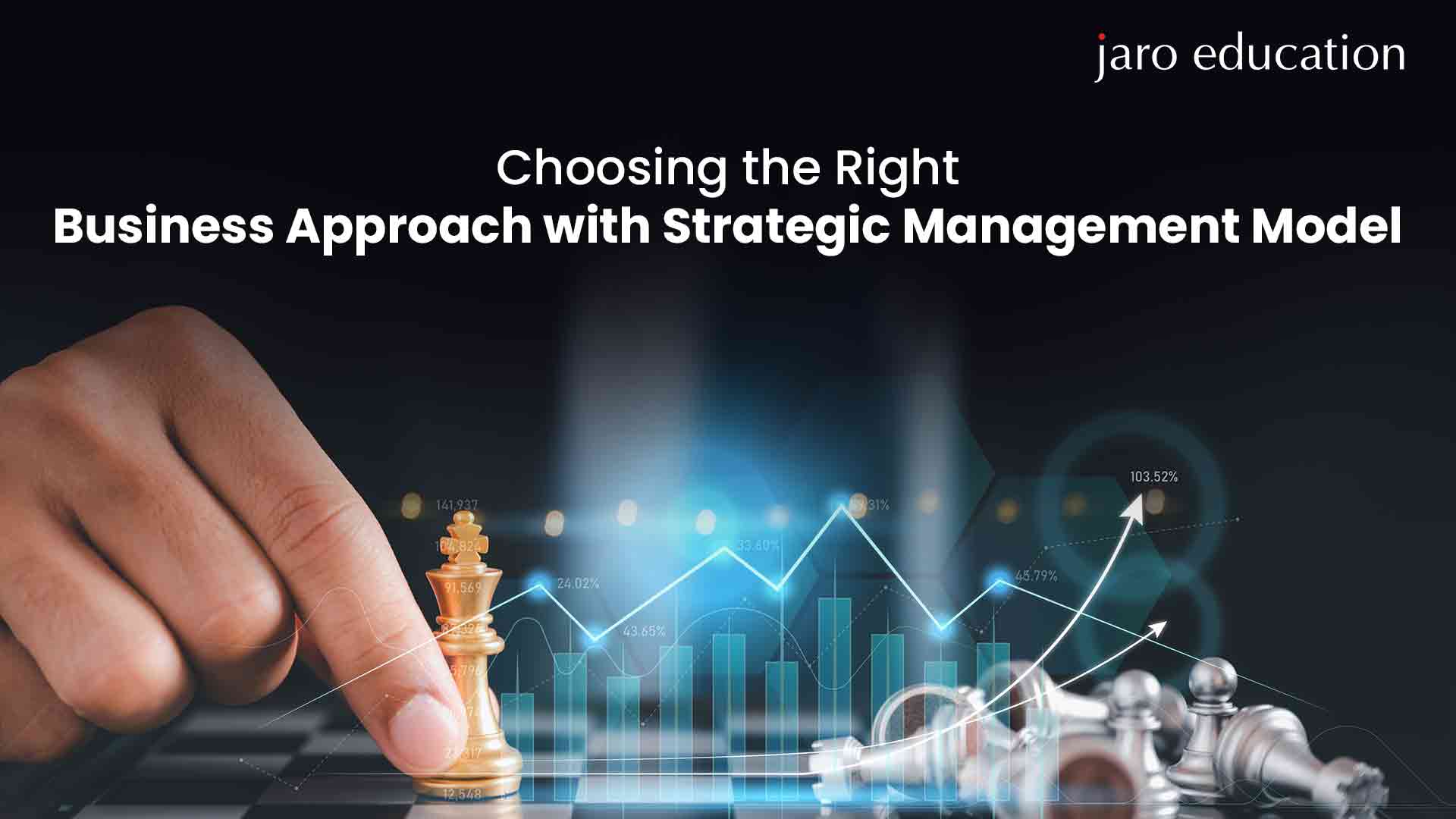
- jaro education
- 25, December 2023
- 11:00 am
One of the basic requirements for running a business is bringing about an alignment between the people, systems, measures, and sales. An organisation has to sync all of these towards the achievement of a common goal for the organisation. This is where the strategic management model comes in. It is a framework that organisations use today to make business decisions and plan for the future. It includes setting goals, analysing the internal and external environment of the organisation, planning and implementing strategies, evaluation, and finally, making rectifications as and when required.
Choosing the best strategy for any business requires a careful study of the type of business and its deliverables. Professionals working in the sphere of business management, aiming to lead transformation within global organisations must join a professional programme, like the Professional Certificate Programme in Strategic Management offered by IIM Kozhikode. It is a programme which IIM has created for ambitious individuals aiming to work as holistic leaders with the ultimate desire to take any company towards global excellence.
What Is Strategic Management Model?
Table of Contents
A strategic management model is a framework which helps an organisation to achieve its goals comprehensively. It mainly focuses on a specific strategy adopted by an organisation and involves a thorough analysis of the environments within and outside the firm. Additionally, it focuses on the overall well-being of the organisation. Strategic management integrates areas like marketing, finance, accounting, human resources, IT, and production, to generate favourable consequences for the organisation. The model is extremely crucial, as it can assist in the operationalisation of strategies. Moreover, it gives business leaders and managers a business pathway to tread on. Alos, the model comprises both macro and micro elements of the business entity.

The main components of strategic management include:
Strategy Development
The main elements that comprise strategy development are vision, mission, and the goals of the organisation. Some of the other aspects that are connected to this stage are analysis of the internal and external environments, selection of the right strategies for the organisation, competitor analysis, selection of the right strategies for the specific business sector, and many more. This component further includes the vision, mission, goals, objectives, and various levels of analysis for the business.
Strategy Implementation
Any organisation must move on to the implementation stage, without which all the planning and formulation will lead to zero results. Three main micro elements impact the implementation stage, and they are organisational hierarchy, human resources, and organisational systems. It is the stage of action for the organisation which will finally yield the desired results. It translates into the business approach, whose fulfillment often leads to various bottlenecks for an organisation.
Strategy Survey and Control
This is the third most important component, which includes exclusive evaluation and measurement of the achieved results against set KPIs according to the business and industry. Moreover, rectification steps are also formulated to yield better outcomes if previous outcomes are not satisfactory. Furthermore, experts associated with the organisation do competitor analysis to find out the differences between projected and achieved results over a period of time.
The strategic management model has to be clearly defined so that everyone involved can understand and co-relate with the strategic management process in a better and more simplified manner.
Choosing The Right Strategic Approach For Any Business
The organisation needs to choose the right strategy for its growth and proliferation. The first step to ascertain the same is to find out the business environment in which the company is operating. Every business environment consists of two dimensions – a predictable one and a malleable one.
These two dimensions of the business environment call for a specific strategic approach. As the business environment has become more diverse than before, picking the right strategy is extremely crucial for business success. There are five broad categories of approach mentioned herein.
Classical Approach
– It is a traditional approach based on a comprehensive analysis of the business environment and proper planning. In this approach, one will study the phases of analysis, planning, deployment, and execution. It is a highly predictable approach which has gained a lot of popularity across various industries. Industries which have achieved a level of maturity generally use this approach in business.
Adaptive Approach
– This approach mainly applies to fast-moving sectors where a lot of experimentation is required. It is useful in unpredictable environments, where the technologies and patterns of consumer demand continuously change.
Visionary Approach
– This is an approach taken by organisations that aim to conquer the market in one strike and finish all sorts of completion by disrupting existing markets. Most organisations which come up with game-changing products and services adopt this strategy. It aims to influence the business environment rather than adapting to it.
Shaping Approach
– It works in collaborative business environments that are unpredictable yet malleable. Organisations working in such environments are leveraging digital ecosystems to create a base for the future, along with strengthening business interactions.
Renewal Approach
– Organisations facing fierce competition and other harsh challenges take up this approach. In such a scenario, such organisations take deliberate actions within a limited time to rectify the loopholes in the preconceived strategy. There is very little room for a comprehensive analysis at this point for the organisation. Survival is considered very important in this case.
Thus, organisations that are able to choose the right approach can move towards the zenith of success. However, most businesses today are unable to match their strategy to the environment. The main reason behind this is the possible inclination of most organisations towards the classical approach. Although with a traditional model, organisations cannot cope with the changing business environment with this one single approach in today’s times.
Hence, the choice of the right strategy is extremely important for the survival of any organisation in the current times. It also assists the organisation in creating systems and structures that drive performance.
Importance Of Strategic Management In Today’s Scenario
The strategic management process is a business approach that mainly allows the top leadership of the organisation to chart out favourable outcomes. It involves the creation of a roadmap which is suitable for the sector and the competitive environment and also leads to positive outcomes. Here are the benefits organisations can witness by having a strategic management model in place.
- Strategic management is important, as it plays a transformative role in leading organisations to success. It is the only approach that helps in seeing future potential issues. Moreover, it assists an organisation in making decisions based on long-term predictions rather than making baseless assumptions. Besides that, it offers various financial advantages over others. It involves numbers and logical reasoning, allowing organisations to set quantitative measurements of deliverables.
- It also impacts the workforce dynamics of the organisation, wherein the employees know their ultimate goal. Thus, they are aware of the expectations of the management and strive to reach their targets in an uninhibited manner.
- By employing strategic management, one can outline the specific deliverables from each department and individual employees, as well. It creates demarcations in job roles and responsibilities. So, there remains no confusion regarding the delegation of tasks and outcomes. It also ensures that seniors in the management cadre can take a common stand on various processes and systems within the organisation.
- Strategic management also takes into account the group dynamics within the organisation. It encourages group discussions, which result in brainstorming. The ultimate results are favourable for the organisation as a whole. As different opinions are weighed against set parameters, organisational leaders can choose one that is right for the organisation in the present circumstances.
- A proper strategic business approach also leads to better employee motivation and engagement. Employees and managers are able to understand their roles better, which leads to better outcomes. It results in achievement-oriented behaviour. Employees are aware of the changing scenarios surrounding the business and are more flexible, as a result. It also helps organisations to cope with changes. It is one of the biggest fears in the minds of the management as well as employees. Once accustomed to specific processes and systems, employees resist changes more often than not. However, an organisation with clear strategic management processes, implemented while taking everyone into confidence, allows practical route changes.
Steps of the Strategic Management Process
Identification of Intent
– This is the first step towards the implementation of strategic management. It involves the setting up of organisational goals and using them as a set parameter to measure outcomes. These mostly follow the SMART goal theory.
Analysis of Operational Scenario
– Analysis and proper research follows intent. The SWOT analysis tool is used in this context to examine the roadmap and bring about changes as required.
Strategy Formulation
– This step involves the formulation of the strategy based on the environmental analysis of the business. It helps to create a realistic and actionable plan for the organisation.
Execution of the Plan
– This is the fourth step in the strategic management process. It involves putting the plan into action. Moreover, one must monitor the outcomes and make corrective changes from time to time.
Evaluation of the Plan
– In this step, the organisation has to measure the outcomes against the set parameters. It also involves feedback and analysis. It prepares the organisation for the best outcomes in the near future.
Conclusion
In the ever-changing business scenario, a proper strategy can only lead an organisation to the zenith of success. The strategic business model serves as the framework for any business to work on. A ship without a destination reaches nowhere. So, if there is no goal or objective, no business can succeed. It also involves making important business decisions and resolving issues, apart from taking advantage of opportunities. Leaders are also better enabled to take the organisations towards a specific direction without any ambiguity.
The Professional Certificate Programme in Strategic Management, offered by IIM Kozhikode, is one of the best courses for management professionals. If you intend to grow into an organisational leader, you must enroll yourself for this course. It is a new-age course for changing business scenarios and has formulated the most comprehensive syllabus, which focuses on real-time business environments along with excellent teaching pedagogy. It also equips future leaders to take their organisations forward amidst all kinds of competition and global upheavals.









